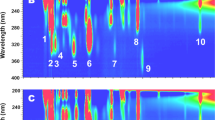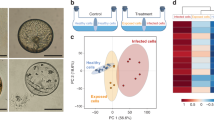Abstract
Ascidians are a notable source of nitrogen-bearing secondary metabolites with a wide range of biological activities. Although many biologically active compounds have been isolated from ascidians, it is often unclear whether the animal or associated microbial symbionts such as bacteria or fungi are the true biosynthetic source of the metabolites. We have addressed the question of the biosynthetic source of the alkaloids granulatimide and isogranulatimides by localizing these compounds within the ascidian. In this work, we demonstrate that granulatimide is stored in Didemnum granulatum tunic bladder cells. Analysis by confocal fluorescence microscopy at the granulatimide emission range indicated the presence of fluorescent cells as highly vacuolated cells found dispersed in the ascidian tunic. Since this is the most exposed ascidian tissue, it is possible that these alkaloids may have a protective role, either as sunscreens and/or as feeding deterrents.








Similar content being viewed by others
References
Amador ML, Jimeno J, Paz-Ares L, Cortes-Funes H, Hidalgo M (2003) Progress in the development and acquisition of anticancer agents from marine sources. Ann Oncol 14:1607–1615
Behmer OA, Tolosa EMC, Freitas Neto AG (1976) Manual de técnicas de histologia normal e patológica. EDART/EDUSP, Sao Paulo
Berlinck RGS, Britton R, Piers E, Lim L, Roberge M, Rocha RM, Andersen RJ (1998) Granulatimide and isogranulatimide, aromatic alkaloids with G2 checkpoint inhibition activity isolated from the Brazilian ascidian Didemnum granulatum: structure elucidation and synthesis. J Org Chem 63:9850–9856
Bibby TS, Nield J, Chen M, Larkum AWD, Barber J (2003) Structure of a photosystem II supercomplex isolated from Prochloron didemni retaining its chlorophyll a/b light-harvesting system. Proc Natl Acad Sci USA 100:9050–9054
Blunt JW, Copp BR, Munro MHG, Northcote PT, Princep MR (2005) Marine natural products. Nat Prod Rep 22:15–61
Britton R, de Oliveira JHHL, Andersen RJ, Berlinck RGS (2001) Granulatimide and 6-bromogranulatimide, minor alkaloids of the Brazilian ascidian Didemnum granulatum. J Nat Prod 64:254–255
Bugni TS, Ireland CM (2004) Marine-derived fungi: a chemically and biologically diverse group of microorganisms. Nat Prod Rep 21:143–163
Dunham P, Weissmann G (1986) Aggregation of marine sponge cells induced by Ca pulses, Ca ionophores, and phorbol esters proceeds in the absence of external Ca. Biochem Biophys Res Commun 134:1319–1326
Faulkner DJ (2002) Marine natural products. Nat Prod Rep 19:1–48
Faulkner DJ, Newman DJ, Cragg GM (2004) Investigations of the marine flora and fauna of the Islands of Palau. Nat Prod Rep 21:50–76
Groepler W, Schuett C (2003) Bacterial community in the tunic matrix of a colonial ascidian Diplosoma migrans. Helgoland Mar Res 57:139–143
Hildebrand M, Waggoner LE, Lim GE, Sharp KH, Ridley CP, Haygood MG (2004) Approaches to identify, clone, and express symbiont bioactive metabolite genes. Nat Prod Rep 21:122–142
Hirose E (1992) Tunic cells in Leptoclinides echinatus (Didemnidae, Ascidiacea): an application of scanning electron microscopy for paraffin embedding specimens. Hiyoshi Rev Natur Sci 11:5–8
Hirose E (2001) Acid containers and cellular networks in the ascidian tunic with special remarks on ascidian phylogeny. Zool Sci 18:723–731
Hirose E, Aoki M, Chiba K (1996) Fine structure of tunic cells and distribution of bacteria in the tunic of luminescent ascidian Clavelina miniata (Ascidiacea. Urochordata). Zool Sci 13:519–523
Hirose E, Ishii T, Saito Y, Taneda Y (1994) Seven types of tunic cells in the colonial ascidian Aplidium yamazii (Polyclinidae, Aplousobranchia): morphology, classification and possible functions. Zool Sci 11:737–743
Hirose E, Ohtsuka K, Ishikura M, Maruyama T (2004) Ultraviolet absorption in ascidian tunic and ascidian-Prochloron symbiosis. J Mar Biol Assoc UK 84:789–794
Hirose E, Saito Y, Watanabe H (1991) Tunic cell morphology and classification in Botryllid ascidians. Zool Sci 8:951–958
Hirose E, Yamashiro H, Mori Y (2001) Properties of tunic acid in the ascidian Phallusia nigra (Ascidiidae, Phlebobranchia). Zool Sci 18:309–314
Horton PA, Longley RE, McConnell OJ, Ballas LM (1994) Staurosporine aglycone (K252-C) and arcyriaflavin-A from the marine ascidian, Eudistoma sp. Experientia 50:843–845
Jeedigunta S, Krenisky JM, Kerr RG (2000) Diketopiperazines as advanced intermediates in the biosynthesis of ecteinascidins. Tetrahedron 56:3303–3307
Jiang X, Zhao B, Britton R, Lim LY, Leong D, Sanghera JS, Zhou B-BS, Piers E, Andersen RJ, Roberge M (2004) Inhibition of Chk1 by the DNA damage checkpoint inhibitor isogranulatimide. Mol Cancer Ther 3:1221–1227
Jimeno J, Lopez-Martin JA, Ruiz-Casado A, Izquierdo MA, Scheuer PJ, Rinehart KL (2004) Progress in the clinical development of new marine-derived anticancer compounds. Anti Cancer Drug 15:321–329
Kerr RG, Miranda NF (1995) Biosynthetic studies of ecteinascidins in the tunicate Ecteinascidia turbinata. J Nat Prod 58:1618–1621
Kühl M, Larkum AWD (2002) The microenvironment and photosynthetic performance of Prochloron sp. in symbiosis with didemnid ascidians. In: Seckbach J (eds) Cellular origin and life in extreme habitats: symbiosis, mechanisms and model systems. Kluwer Academic, Dordrecht, pp 273–290
Lindquist N, Fenical W (1991) New tambjamine class alkaloids from the marine ascidian Atapazoa sp. and its nudibranch predators—origin of the tambjamines in Atapazoa. Experientia 47:504–506
Long PF, Dunlap WC, Battershill CN, Jaspars M (2005) Shotgun cloning and heterologous expression of the patellamide gene cluster as a strategy to achieving sustained metabolite production. ChemBioChem 6:1760–1765
Maruyama T, Hirose E, Ishikura M (2003) Ultraviolet-light-absorbing tunic cells in didemnid ascidians hosting a symbiotic photo-oxygenic prokaryote, Prochloron. Biol Bull 204:109–113
Newman DJ, Cragg GM (2004a) Advanced preclinical and clinical trials of natural products and related compounds from marine sources. Curr Med Chem 11:1693–1713
Newman DJ, Cragg GM (2004b) Marine natural products and related compounds in clinical and advanced preclinical trials. J Nat Prod 67:1216–1238
Omura S, Sasaki Y, Iwai Y, Takeshima H (1995) Staurosporine, a potentially important gift from a microorganism. J Antibiot 48:535–548
Piers E, Britton R, Andersen RJ (2000) Improved synthesis of isogranulatimide, a G2 checkpoint inhibitor. Syntheses of didemnimide C, isodidemnimide A, neodidemnimide A, 17-methylgranulatimide, and isogranulatimides A-C. J Org Chem 65:530–535
Roberge M, Berlinck RGS, Xu L, Anderson H, Lim LY, Curman D, Stringer CM, Friend SH, Davies P, Vincent I, Haggarty SJ, Kelly MT, Britton R, Piers E, Andersen RJ (1998) High throughtput assay for G2 checkpoint inhibitors and identification of the structurally novel compound isogranulatimide. Cancer Res 58:5701–5706
Rottmayr EM, Steffan B, Wanner GG (2001) Pigmentation and tunic cells in Cystodytes dellechiajei (Urochordata, Ascidiacea). Zoomorphology 120:159–170
Sakai R, Jares-Erijman EA, Elipe MVS, Rinehart KL (1996) Ecteinascidins: putative biosynthetic precursors and absolute stereochemistry. J Am Chem Soc 118:9017–9023
Saleh MB, Kerr RG (2004) Oxidation of tyrosine diketopiperazine to DOPA diketopiperazine with tyrosine hydroxylase. J Nat Prod 67:1390–1391
Salomon CE, Faulkner DJ (2002) Localization studies of bioactive cyclic peptides in the ascidian Lissoclinum patella. J Nat Prod 65:689–692
Salomon CE, Magarvey NA, Sherman DH (2004) Merging the potential of microbial genetics with biological and chemical diversity: an even brighter future for marine natural product drug discovery. Nat Prod Rep 21:105–121
Schmidt EW, Suddek S, Haygood MG (2004) Genetic evidence supports secondary metabolic diversity in Prochloron spp., the cyanobacterial symbiont of a tropical ascidian. J Nat Prod 67:1341–1345
Schmidt EW, Nelson JT, Rasko DA, Sudek S, Eisen JA, Haygood MG, Ravel J (2005) Patellamide A and C biosynthesis by a microcin-like pathway in Prochloron didemni, the cyanobacterial symbiont of Lissoclinum patella. Proc Natl Acad Sci 102:7315–7320
Schreiber U, Gademann R, Ralph PJ, Larkum AWD (1997) Assessment of photosynthetic performance of Prochloron in Lissoclinum patella in hospite by chlorophyll fluorescence measurements. Plant Cell Physiol 38:945–951
Schupp P, Eder C, Proksch P, Wray V, Schneider B, Herderich M, Paul V (1999) Staurosporine derivatives from the ascidian Eudistoma toealensis and its predatory flatworm Pseudoceros sp. J Nat Prod 62:959–962
Schupp P, Proksch P, Wray V (2002) Further new staurosporine derivatives from the ascidian Eudistoma toealensis and its predatory flatworm Pseudoceros sp. J Nat Prod 65:295–298
Shen GQ, Baker BJ (1994) Biosynthetic studies of the eudistomins in the tunicate Eudistoma olivaceum. Tetrahedron Lett 35:1141–1144
Shirae M, Saito Y (2000) A comparison of hemocytes and their phenoloxidase activity among botryllid ascidians. Zool Sci 17:881–891
Sings HL, Rinehart KL (1996) Compounds produced from potential tunicate-blue-green algal symbiosis: a review. J Ind Microbiol Biotechnol 17:385–396
Steffan B, Brix K, Pütz W (1993) Biosynthesis of shermilamine B. Tetrahedron 49:6223–6228
Tincu JA, Craig AG, Taylor SW (2000) Plicatamide: a lead to the biosynthetic origins of the tunichromes? Biochem Biophys Res Commun 270:421–424
Tincu JA, Menzel LP, Azimov R, Sands J, Hong T, Waring AJ, Taylor SW, Lehrer RI (2003) Plicatamide, an antimicrobial octapeptide from Styela plicata hemocytes. J Biol Chem 278:13546–13553
Vera MD, Joullié MM (2002) Natural products as probes of cell biology: 20 years of didemnin research. Med Res Rev 22:102–145
Vervoort HC, Gross SER, Fenical W, Lee AY, Clardy J (1997) Didemnimides A-D: novel predator-deterrent alkaloids from the Caribbean mangrove ascidian Didemnum conchyliatum. J Org Chem 62:1486–1490
Vervoort HC, Pawlik JR, Fenical W (1998) Chemical defense of the caribbean ascidian Didemnum conchyliatum. Mar Ecol Prog Ser 164:221–228
Acknowledgments
The authors are particularly grateful to Dr. Christine Salomon (University of Minnesota) for a careful reading of the manuscript and many suggestions to improve it. The authors thank the staff of CEBIMar—USP for the provision of laboratory facilities and technical support during field trips; the staff of the Laboratório de Fisiologia Celular do Plasmodium (IB-USP) for the assistance with confocal microscopy; and Gustavo M. Diaz (Universidade Estadual de Campinas, Brazil) for valuable discussions. Financial support was provided by FAPESP as grants to M.R.C. (99/11443-1) and R.G.S.B. (01/06202-7), and as a scholarship to S.P.L. The authors also thank the Universidade de São Paulo within the PROCONTES program to M.H.R.S. and R.G.S.B. All experiments complied with current Brazilian laws. The authors dedicate this work to the late Professor D. John Faulkner (Scripps Institution of Oceanography), in memoriam.
Author information
Authors and Affiliations
Corresponding author
Additional information
Communicated by M. Kühl, Helsingør
Rights and permissions
About this article
Cite this article
Seleghim, M.H.R., de Lira, S.P., Campana, P.T. et al. Localization of granulatimide alkaloids in the tissues of the ascidian Didemnum granulatum . Mar Biol 150, 967–975 (2007). https://doi.org/10.1007/s00227-006-0410-5
Received:
Accepted:
Published:
Issue Date:
DOI: https://doi.org/10.1007/s00227-006-0410-5




